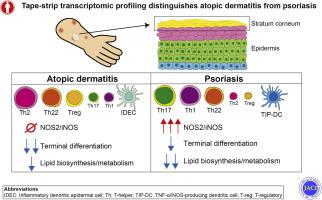Journal of Allergy and Clinical Immunology ( IF 11.4 ) Pub Date : 2020-07-21 , DOI: 10.1016/j.jaci.2020.05.048 Helen He 1 , Robert Bissonnette 2 , Jianni Wu 3 , Aisleen Diaz 4 , Etienne Saint-Cyr Proulx 2 , Catherine Maari 2 , Carolyn Jack 2 , Maudeline Louis 2 , Yeriel Estrada 5 , James G Krueger 6 , Ning Zhang 5 , Ana B Pavel 5 , Emma Guttman-Yassky 1

|
Background
Our current understanding of atopic dermatitis (AD) and psoriasis pathophysiology is largely derived from skin biopsy studies that cause scarring and may be impractical in large-scale clinical trials. Although tape strips show promise as a minimally invasive technique in these common diseases, a comprehensive molecular profiling characterizing and differentiating the 2 diseases in tape strips is unavailable.
Objective
Our aim was to construct a global transcriptome of tape strips from lesional and nonlesional skin of adults with moderate-to-severe AD and psoriasis.
Methods
A total of 20 tape strips were obtained from lesional and nonlesional skin of patients with AD and psoriasis and skin from controls (n = 20 each); the strips were subjected to RNA sequencing (RNA-seq), with quantitative RT-PCR validation of immune and barrier biomarkers.
Results
We detected RNA-seq profiles in 96 of 100 of samples (96%), with 4123 and 5390 genes differentially expressed in AD and psoriasis lesions versus in controls, respectively (fold change ≥ 2; false discovery rate [FDR] < 0.05). Nonlesional tape-stripped skin from patients with AD was more similar to lesional skin than to nonlesional skin of patients with psoriasis, which showed larger differentiation from lesions. AD and psoriasis tissues shared increases in levels of dendritic cell and T-cell markers (CD3, ITGAX/CD11c, and CD83), but AD tissues showed preferential TH2 skewing (IL-13, CCL17/TARC, and CCL18), whereas psoriasis was characterized by higher levels of expression of TH17-related (IL-17A/F and IL-36A/IL-36G), TH1-related (IFN-γ and CXCL9/CXCL10), and innate immunity–related (nitric oxide synthase 2/inducible nitric oxide synthase and IL-17C) products (FDR < 0.05). Terminal differentiation (FLG2 and LCE5A), tight junction (CLDN8), and lipid biosynthesis and metabolism (FA2H and ALOXE3) products were significantly downregulated in both AD and psoriasis (FDR < 0.05). Nitric oxide synthase 2/inducible nitric oxide synthase expression (determined by quantitative PCR) differentiated AD and psoriasis with 100% accuracy.
Conclusion
RNA-seq tape strip profiling detected distinct immune and barrier signatures in lesional and nonlesional AD and psoriasis skin, suggesting their utility as a minimally invasive alternative to biopsies for detecting disease biomarkers.
中文翻译:

胶带检测特应性皮炎和牛皮癣中不同的免疫和屏障特征。
背景
我们目前对特应性皮炎 (AD) 和银屑病病理生理学的理解主要来源于皮肤活检研究,这些研究会导致瘢痕形成,在大规模临床试验中可能不切实际。尽管胶带条显示出作为这些常见疾病的微创技术的前景,但无法进行全面的分子分析来表征和区分胶带条中的两种疾病。
客观的
我们的目标是从患有中度至重度 AD 和银屑病的成年人的病变和非病变皮肤中构建胶带条的全球转录组。
方法
从 AD 和银屑病患者的病变和非病变皮肤以及对照皮肤(每个 n = 20)获得总共 20 条胶带;对这些条带进行 RNA 测序 (RNA-seq),并对免疫和屏障生物标志物进行定量 RT-PCR 验证。
结果
我们在 100 个样本中的 96 个 (96%) 中检测到 RNA-seq 谱,其中 4123 和 5390 个基因分别在 AD 和银屑病病变中与对照组相比差异表达(倍数变化 ≥ 2;错误发现率 [FDR] < 0.05)。AD 患者的非损伤性胶带剥离皮肤与牛皮癣患者的非损伤性皮肤相比,与损伤性皮肤更相似,与皮损的区别更大。AD 和银屑病组织的树突状细胞和 T 细胞标志物(CD3、ITGAX/CD11c 和 CD83)水平均增加,但 AD 组织表现出优先的 T H 2 偏斜(IL-13、CCL17/TARC 和 CCL18),而银屑病的特点是 T H 17 相关(IL-17A/F 和 IL-36A/IL-36G)、T H1 相关(IFN-γ 和 CXCL9/CXCL10)和先天免疫相关(一氧化氮合酶 2/诱导型一氧化氮合酶和 IL-17C)产物(FDR < 0.05)。终末分化(FLG2 和 LCE5A)、紧密连接(CLDN8)和脂质生物合成和代谢(FA2H 和 ALOXE3)产物在 AD 和银屑病中均显着下调(FDR < 0.05)。一氧化氮合酶 2/诱导型一氧化氮合酶表达(通过定量 PCR 测定)以 100% 的准确度区分 AD 和银屑病。
结论
RNA-seq 胶带分析在病变和非病变 AD 和银屑病皮肤中检测到不同的免疫和屏障特征,表明它们可用作检测疾病生物标志物的活检的微创替代方案。









































 京公网安备 11010802027423号
京公网安备 11010802027423号